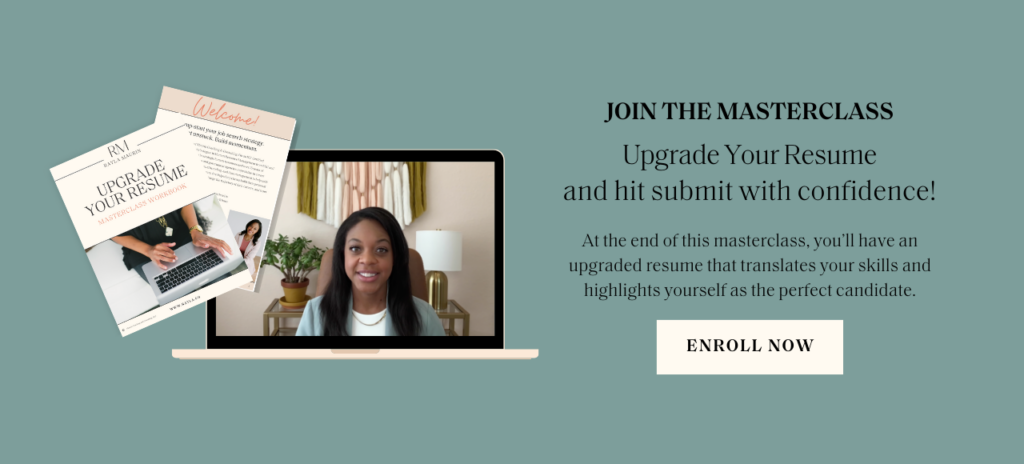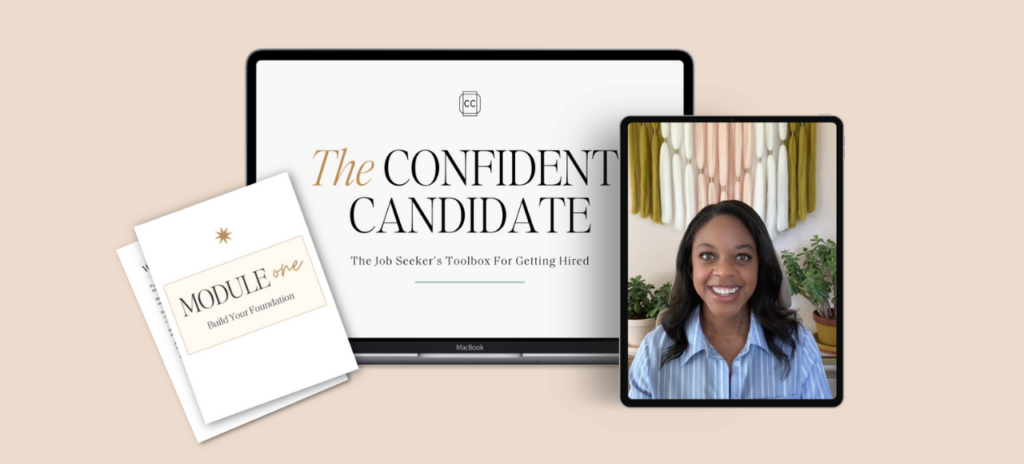Have you ever saved a long list of jobs on Indeed or LinkedIn to apply to later, only to find that MOST of them have already closed by the time you’re ready to apply?
It keeps you stuck in a frustrating cycle of constantly searching for a new job but never quite landing that perfect role.
The key to breaking free from this job search hamster wheel is organization (which is why I made this for you).
As someone who has had to pivot to new industries, experienced a mass layoff, and been promoted at three different companies, I can promise you that these next 8 steps to finding a job will make the process much easier.
RELATED: Not getting job interviews? This is why.
8 Steps To Finding a Job That’ll Save You Hours Every Week
The best way to find a job is to start by knowing what you want and why.
Sure, you might be feeling desperate to escape your current situation—and I get it!
But let’s pause for a second.
Right now is your chance to find a job that not only pays the bills but also aligns with your goals, values, and skills.
I’ve personally done this and have helped many of my career coaching clients find their Dream Job using my “What, Why, How” Framework.
These steps will help you figure out exactly what you’re aiming for, why it matters, and how to make it happen.
Step 1. Commit to Making It Happen
What: The first step to finding a job is committing to making it happen. There’s no sugarcoating it—job hunting takes effort and strategy. Everyone agrees that staying organized is how you’re going to get a job faster.
Why: Treat your job search like a job itself; set specific hours to apply, deadlines, and tasks to help you avoid feeling like you’re constantly chasing your tail. Plus, having a structured approach boosts your confidence and keeps you from getting bogged down by the little stuff.
How: Grab this simple planner to help you get clear on your job search goals. This planner should be your go-to tool, letting you print, highlight, and mark off tasks as you complete them.
Remember: The right role is out there, but it won’t fall into your lap.
Step 2. Know Your Qualifications
What: The second step to finding a job involves knowing your qualifications. This is about more than just listing skills on your resume. It’s about understanding how your industry hires and what they’re looking for.
Why: Aligning your job search strategy with your qualifications ensures that you’re applying for roles that match your expertise and goals. It’s not just about getting any job but about getting the right job for you.
How: First, research the hiring trends within your industry. Take not of which qualifications are repeated the most often. Then, tailor your resume and LinkedIn profile to showcase these skills. Here’s how.
RELATED: How To Write A Resume for a Career Change
Step 3. Salary Research
What: The third step in finding a job is salary research. Knowing your worth is non-negotiable. Before you apply, it’s crucial to research compensation for the roles you’re interested in.
Why: This step ensures you’re not undervaluing yourself and sets the stage for productive salary discussions during interviews. Staying informed about market rates will position you as a confident, knowledgeable candidate who can negotiate confidently.
How: Use online tools like Glassdoor and Payscale to research typical salaries in your field (in your area). Start by pulling 5–10 job listings with salary information, add those salaries together, and then divide by the number of listings to get the average.
For example:
- Job 1: $72K
- Job 2: $78K
- Job 3: $75K
- Average = ($72K + $78K + $75K) ÷ 3 = $75K
Once you know the average, build in room for negotiation by aiming 10–20% higher than the number you’d actually accept. Once you know the average, add 10–15% when stating your desired salary. So, if the average is $75K and that’s your minimum, you’d ask for $82–85K. This gives the company room to counter, and you’re more likely to land at or just above the number you want.
RELATED: The Confident Candidate Course
4. Build Your Assets
What: The fourth step to finding a job is all about building your assets. This involves updating your resume, cover letter, LinkedIn profile, headshot, and elevator pitch. These are your first impressions, so make them count!
Why: A strong personal brand makes you memorable to recruiters. It shows you’re serious about your career and ready to hit the ground running.
How: Tailor each resume to fit the roles you’re applying for (I know it sounds time-consuming, but remember, treat your job search like a job itself!). Highlight achievements, skills, and experiences that match the job description. Here are all the things to include in your resume.
Also, your cover letter shouldn’t be a recap of your resume! It should show your enthusiasm for the role and demonstrate how you align with the company’s values (because you researched that, too, right?!).

5. Engage With Your Network
What: The fifth step to finding a job is all about networking. Resumes might get you past the ATS machines, but networking is what can get your resume into the right hands. And if you want to get a job FAST, you should build relationships before you even send your CV. Plus, networking can help you find hidden opportunities that aren’t advertised publicly.
Why: Over 70% of jobs are never posted online. It’s called the Hidden Job Market. Most roles are filled via networking, referrals, or internal moves rather than just job boards.
How: If you’re looking to leave your current company, start by connecting with former colleagues on LinkedIn. Research the company to see if it’s somewhere you’d like to work, and ask a colleague for a referral (here’s how to ask for referrals, by the way). If you can’t think of anyone, look for a company you want to work at, find their recruiter, and send them a message.
RELATED: How To Politely Ask For a Job: 5 In-Person and Email Scripts
6. Prepare For The Interview
What: If you’ve snagged an interview, you don’t want to blow it by winging it.
Why: Interviews are your chance to shine. Proper preparation ensures you convey confidence and make a memorable impression.
How: Research the company, review the job description, and prepare answers to common questions. Be ready to discuss your qualifications and how they align with what the company needs. Practice articulating your strengths and past achievements with clarity and confidence (honestly, the best way to do this is with mock interview practice 1-on-1 with a career coach— like me!).
FREEBIE: 10 Questions to Ask in a Job Interview
7. Follow Up
What: The seventh step to finding a job is the follow-up. After the interview, don’t just vanish into the ether. Follow-up is crucial to leave a lasting impression.
Why: A well-timed follow-up message shows you’re still interested and can keep you on the recruiter’s radar without being pushy.
How: Send a thank you email the day after your interview, expressing your appreciation for the opportunity and reiterating your enthusiasm for the role. A week later, send a gentle nudge if you haven’t heard back. Here are some email templates you can use!
8. Accepting Your Offer
What: Congratulations are in order! This is where you see the ROI on all your hard work.
Why: Accepting an offer you’re excited about is the culmination of your job search journey. This is where all your preparation, networking, and interviews lead to real-world success.
How: Take the time to review the offer carefully. Consider not just the salary but also the benefits, work-life balance, career growth opportunities, and how well the role aligns with your personal and professional goals. Be sure you’re making the decision that’s best for you, not just the easiest one.

How long does it take to find a job?
If you have a strong network and you’re treating your job search like a part-time job, you can find a job in as little as 1-3 months.
But like most things, the timeline depends on your industry, experience, and how intentional you are with your search.
If you’re applying to random roles without a plan and copy/pasting job descriptions under your Experience section… expect it to drag on.
But if you’re focused, organized (i.e., you’re using my free planner), and expanding your network so you have find those Hidden Jobs, you’ll speed things up.
Don’t get discouraged! Just make sure you’re networking once pe week, tailoring your applications, and preparing for interviews like it’s your full-time gig.
Remember, the goal isn’t just to find any job; it’s to find the right job for you.
TLDR; What are the best ways to finding a job?
- Commit to Making It Happen: Stop procrastinating. Get organized using this planner and set clear goals for your search.
- Know Your Qualifications: Understand what makes you valuable and how to align that with the jobs you want. I wrote a whole blog on this.
- Research Salaries: Know your worth so you can confidently negotiate without leaving money on the table. Find the average salary in your area by using Glassdoor and Payscale.
- Build Your Assets: Polish your resume, cover letter, LinkedIn profile, and all the tools that show you mean business. Start with my free guide so you can Upgrade Your LinkedIn today, and then learn how to write templates for various job roles inside The Confident Candidate Course!
- Engage Your Network: Reach out, connect, and leverage relationships to open doors.
- Prep For Interviews: Practice your answers, anticipate questions, and show up ready to impress. Here are 10 Questions to Ask in a Job Interview.
- Follow Up: Don’t ghost the process—thank interviewers and remind them why you’re the best choice. Use these email templates.
- Seal The Deal: Evaluate your offers, negotiate confidently (I can help directly with this part), and accept the role that fits your goals.
Want to make the job search process even easier? Join The Confident Candidate Course to learn how to become a candidate that’s impossible to ignore.

+ show Comments
- Hide Comments
add a comment